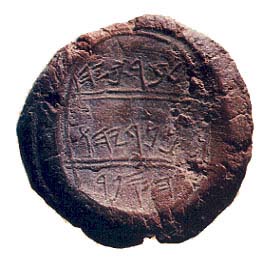Image Details

David Harris/Israel Museum, Jerusalem
The inscription on this bulla appears in three registers, each separated by a pair of parallel lines. The three lines of paleo-Hebrew script read: “Belonging to Berekhyaku / son of Neriyahu / the scribe.” Baruch means “the blessed,” and the suffix –yahu is a form of Yahweh, so Berekhyahu means “blessed of Yahweh.” This full form of Baruch’s name was not known before the discovery of this bulla, because the suffix was dropped in the Biblical spelling. In other names the suffix is usually spelled –iah in the Bible, hence Neriyahu becomes Neriah.
This bulla is part of a hoard obtained on the antiquities market by a private collector. Several factors, however, strongly suggest its identification with the Biblical Baruch: The script is consistent with that used in Baruch’s time, the end of the seventh and beginning of the sixth centuries B.C.E.; the genealogy matches the Bible; the bulla is associated with another biblically connected bulla in the same hoard; and the bullae in the hoard are baked hard, as they would be if they were caught in the fiery destruction of Jerusalem in 587/586 B.C.E.
